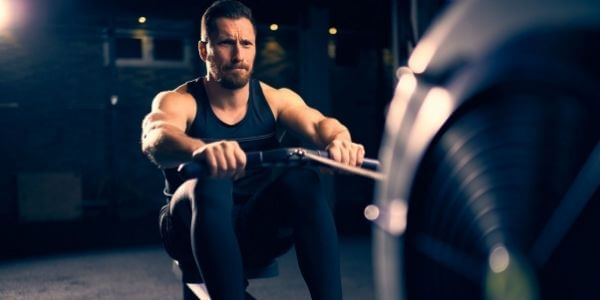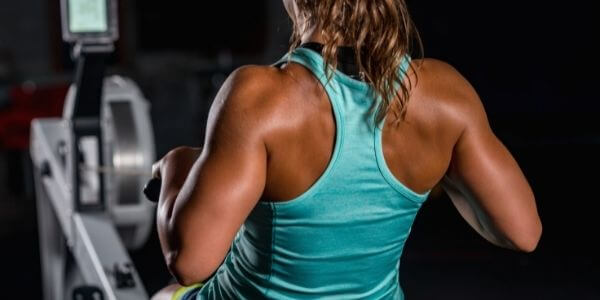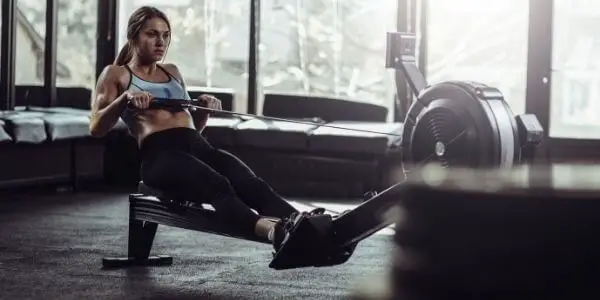Rowers are renowned for their ability to build powerful muscles. After all, actors like Hugh Jackman, Jason Statham, and Gerard Butler used rowers to get in shape for their roles.
So it’s no wonder everybody has fallen in love with the idea of owning a rower.
Or the body you get from using one.
But there’s more to these machines than simply building the body of an Adonis. We’ll uncover the science behind rowing machine benefits, highlighting some risks to avoid.
In the end, we’ll tell you a bit about how to choose the right rower for your needs, so keep reading below!
Table of Contents
Rowing Machine Workout Benefits
Let’s start with the benefits of using a rowing machine:
1. High Calorie Burn
Rowing benefits weight loss because of two reasons:
One, it’s intense cardio. You’re going to be using your entire body during your workout, pushing and pulling with all your muscles. According to Harvard, a 30-minute session gets rid of around 300 calories.
However, this Harvard study above shows that other indoor fitness machines have the same calorie output. For example, using the elliptical or the treadmill could bring you up to 400 calories burned in 30 minutes.
So why pick a rowing machine if all you care about is quick weight loss?
That brings us to point number two:
Rowing is resistance training. That means challenging yourself on the rower builds lean muscle mass. And as you know, lean muscles accelerate your basal metabolic rate (BMR) so that you can burn more calories at rest.
Basically, a rower will help you lose considerable amounts of weight in the long term if you’re using it wisely.
2. Improved Stamina

The rowing exercise benefits your aerobic fitness because it strengthens your heart and lungs.
Here’s how:
When you start pushing and pulling on that rower, you activate all your muscles. Your heart starts beating faster, and your breathing quickens.
You’ll notice at first that your breathing may get shallow, so at this point, you’re going to force yourself to take deeper breaths even when you’re making a lot of effort.
That leads to a stronger heart and stronger lungs.
Basically, you’re going to educate and fortify your body to resist intense effort.
And that’s precisely the definition of stamina.
Why do you need more endurance?
You could think of any number of day-to-day activities that require increased stamina, such as playing with your kids, running with your dog, and keeping your house clean.
Besides, stamina is essential if you’re preparing for a hike or a marathon or simply want to feel more empowered.
3. Total Body Workout
Rowers use 86% of your body’s muscles, according to Healthline. However, 70% of that amount is leg work, and 30% is upper body exercise.
You’re going to be using your:
- Deltoids
- Pectoral muscles
- Biceps
- Triceps
- Quads
- Glutes
- Hamstrings
- Quads
- Core
Here’s what that tells us:
Firstly, you’re going to burn a lot more calories and even fat.
Using your entire body during your workout activates more muscles. Those muscles, in turn, require more glucose to burn. When your body has no more available glucose, it starts burning through your fat stores.
Secondly, the rowing machine benefits stomach muscles. You’re going to contract your abs and obliques quite a lot, but you’ll also push and stretch your lower back. That way, you’re going to get a stronger core that helps you maintain a correct posture throughout the day. The result is decreasing your risk of chronic back pain, sciatica, or compressed discs.
Thirdly, working out your entire body saves a lot of time.
In a 30-45 minute workout, you can kick your own butt well enough to see the improvements you need. Besides, you’re probably not going to want to work out the next day because your muscles will still be sore, and they need plenty of time to recover.
That frees up your day for many other more pleasant activities or even rest-day exercises, such as yoga, swimming, or hiking.
4. Build More Strength

A rowing workout benefits your strength levels because your muscles will have to work against a high resistance level. Using a rower is like doing deadlifts, leg presses, and seated rows all at once.
So the higher you raise that resistance, the more lean muscles you’re going to build.
That lean muscle will help you burn more fat stores in the long run, whereas long-term steady-state cardio leads to muscle loss.
Muscle strength has numerous advantages:
- Accelerating your metabolic rate to reach your weight loss goals
- Accelerating your metabolic rate to avoid age-related weight gain
- Shaping your body and not just thinning it out
- Increased balance and flexibility
- Better ability to hold a correct posture
- Stabilizing your insulin levels
- Avoiding/ improving high cholesterol & type 2 diabetes
5. Works For Everyone
Rowing machines are low-impact, even if they burn a lot of calories. Besides, you can set the resistance to a low level and move slowly at the beginning. Then, you can row faster when you gain more strength and endurance and set your machine at higher resistance levels.
That means rowing machines are scalable and easy to adjust according to your needs.
Invest in a quality one now, and you’re going to be using it for years without experiencing a plateau.
But there’s another thing:
Rowers have a reduced risk of injury.
Rowing machines are low-impact, and so you can make a lot of effort on one without putting too much pressure on your joints. If your joint pain prevents you from using a treadmill or stationary bike, you can use a rower, according to your doctor’s advice.
For example, many physical therapists recommend rowers for shoulder injury rehab, but it’s always best to consult with your own doctor.
Rowing Machine Disadvantages

Now that we’ve discussed rowing machine exercise benefits let’s move on to the risks.
1. Rowers aren’t good enough for bone strengthening. You’re going to need to incorporate weight-bearing exercise into your routine if you want to curb bone demineralization. Walking is a good alternative for your rest days, for example.
2. Rowers aren’t great if you have a back injury. When you’re pushing and pulling on the rower, your lower back moves too much. Besides, if your muscles are doing too much effort and get fatigued, you tend to lose that correct posture. As a result, you’ll worsen your back injury/ pain.
3. Rowers are complex. It can seem easy to simply hop on that rowing machine and start doing your thing, but you need to learn coordination and proper posture. Watch a few videos until you figure out how to row correctly. After you create those reflexes, you won’t have to focus on your movements all the time.
4. Rowing is easy to overdo. Rowers are fun, and they can get pretty addictive. Moreover, your heart rate creeps up without feeling exhausted because you’re using your entire body. As a result, it’s easy to push yourself more than your body can handle. Remember, though, that overtraining leads to injury and fitness plateaus.
In Conclusion
If you’re here, you now know the health benefits of rowing machines as well as their risks. But here’s the gist: not all rowers are created equal.
So even if all of them offer low-impact total body workouts that help you burn calories galore, you’ll find different models on the market. Likewise, you’ll notice various features, such as resistance types or designs.
That’s why you should always consider your needs and fitness goals before choosing a rower. Some are best for strength training, others for steady-state cardio, while others specifically target your upper body.
Also, remember to ask your doctor for advice, especially if you have preexisting health conditions!
- 7 Exercises for Pregnant Women in the First Trimester: Safe and Effective - January 30, 2025
- Our equipment recommendations - October 30, 2024
- Here’s What Doing Cardio Every Day Does To Your Body - August 21, 2024


Thank you for the insight on the rowing machine. I have a few health issues and was told by a PT that this was a good alternative with low impact. Hopefully it will not make my other injuries worse.
Hi Chris,
It’s definitely a good low impact option, and as long as you take it easy at first and build up your time gradually, you should be fine. Definitely let the PT or your doctor know if you start experiencing any pain or discomfort, so they can adjust your routine as needed.
Happy rowing!